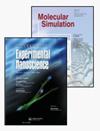孪晶γ-TiAl合金力学性能及组织演变的纳米压痕模拟研究
IF 2
4区 化学
Q4 CHEMISTRY, PHYSICAL
引用次数: 0
摘要
本文章由计算机程序翻译,如有差异,请以英文原文为准。
Nanoindentation simulation study on mechanical properties and microstructure evolution of twin γ-TiAl alloy
ABSTRACT
To explore the mechanical properties and deformation mechanism of twin γ-TiAl alloy under load and impact, based on the special interface structure in polycrystals, twinning at room temperature is established in this paper simulation of nanoindentation response of twin γ-TiAl alloy. Through the load-displacement curve, the hardness and Young's modulus of the workpiece are obtained. By analysing the microstructure evolution behaviour under the action of the indenter, it is found that during the loading process, multiple dislocation rings are generated in the grain and slip to the lower part of the workpiece, resulting in the hardness decreasing with the increase of the indentation depth, which is consistent with the indentation size effect; The dislocation lock generated during the unloading process delayed the annihilation of the defect structure, but the dislocation and stacking fault structure disappeared completely and the stress concentrated at the defect residue; in the stress relaxation stage, the dislocation ring structure in the grain extends and annihilates away from the grain boundary, releasing a large amount of stress to reduce the indentation load, and then the defect structure around the indenter is stable to keep the load stable, with high stress at the defect.
求助全文
通过发布文献求助,成功后即可免费获取论文全文。
去求助
来源期刊

Molecular Simulation
化学-物理:原子、分子和化学物理
CiteScore
3.80
自引率
9.50%
发文量
128
审稿时长
3.1 months
期刊介绍:
Molecular Simulation covers all aspects of research related to, or of importance to, molecular modelling and simulation.
Molecular Simulation brings together the most significant papers concerned with applications of simulation methods, and original contributions to the development of simulation methodology from biology, biochemistry, chemistry, engineering, materials science, medicine and physics.
The aim is to provide a forum in which cross fertilization between application areas, methodologies, disciplines, as well as academic and industrial researchers can take place and new developments can be encouraged.
Molecular Simulation is of interest to all researchers using or developing simulation methods based on statistical mechanics/quantum mechanics. This includes molecular dynamics (MD, AIMD), Monte Carlo, ab initio methods related to simulation, multiscale and coarse graining methods.
 求助内容:
求助内容: 应助结果提醒方式:
应助结果提醒方式:


